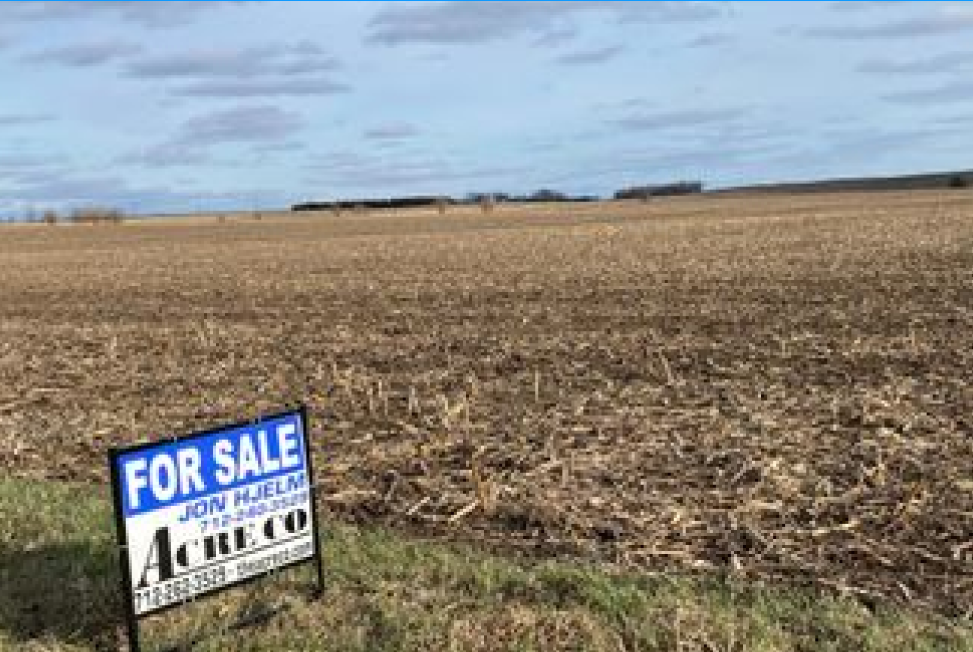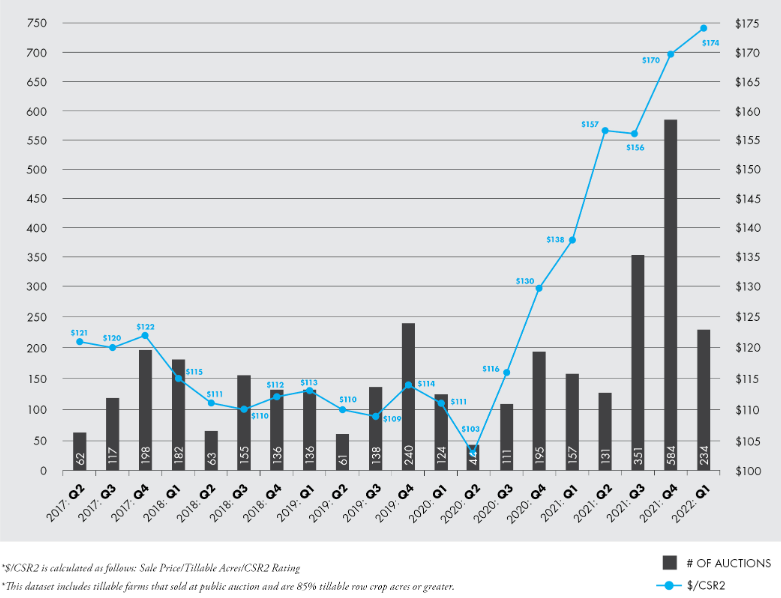“Farmland sale prices in Iowa increased 36 percent from July 1, 2021, to July 1, 2022.”
That’s according to Jim Knuth, senior vice president for Farm Credit Services of America in Iowa.
Farm Credit Services of America is a customer-owned financial cooperative financing farmers and ranchers in Iowa, Nebraska, South Dakota, and Wyoming.
“The increase in land prices is a stunning number,” Knuth told “Successful Farming.”

However, these numbers follow the increase land prices in other recent surveys. In March, the Iowa chapter of the Realtors Land Institute reported a statewide jump in land values of almost 33 percent in the previous year, with high-quality cropland in northwest counties averaging $16,576.
Iowa State University’s most recent Land Value Survey, conducted in November, showed a 29 percent statewide annual increase in land values.
A Purdue University survey released earlier this summer reported new land price records for Indiana. “Our year-over-year change is around 30 percent,” said Todd Kuethe, Purdue agriculture economist.
In June, top-quality Indiana farmland statewide averaged $12,808 per acre. Medium-quality land was at $10,598, while poor-quality land brought $8,631.
About 70 percent of farmland sales tend to occur between September and March, said Steve Bruere, president of Peoples Company, which sells farmland in 30 states.
Drones and satellite technology have recently made it easier to sell land in summer when crops are still in the field. However, the main reason the boom lasted into summer is “just because prices are so strong,” Bruere indicated.
“People who wouldn’t otherwise be selling are saying, ‘With prices as they are, I’m putting it on the market,’” Bruere said.
On the buying side, “there was so much cash out there” from both investors and farmers, Bruere said. “With several unusual USDA payments and corn priced at $8 per bushel, farmers had money to buy land.”
Uncertainty about alternative investments, such as commercial real estate and the stock market, also contributed, Bruere added.
Kuethe listed 10 market drivers: net farm income, growth rate in farm returns, crop prices, livestock prices, current and expected interest rates, alternative investment returns, agricultural export sales, inflation rate, buyers’ cash liquidity, and cut agricultural policy.
“Interest rates are a negative factor this year,” Kueth said. “That’s definitely the biggest change from last year.”
“Farmers with cash haven’t had many options to spend,” Kueth continued. “They can’t buy machinery as easily so you’re looking to add acreage.”
“There’s sort of a belief that farmland is a hedge against inflation,” Kuethe added.
Doug Hensley, president of Hertz Real Estate Services, sees interest rates as the main headwind in today’s farmland market. Hertz sells farms in a dozen states, mainly in the Corn Belt and Great Plains.
Hensley listed four forces driving farmland prices: interest rates, commodity prices, demand for farms, and supply of farmland for sale
“I expect interest in selling land to remain high among farmers who are considering retirement,” Hensley added.
“When high prices come, sales volume comes with it,” Hensley said. “People want to sell into a strong market.”
The strong financial position of most farmers offsets higher interest rates, he noted. “There was a ton of money made last year in agriculture.”
If farmers have money to spend, land is attractive, even though buying machinery offers expensing options for taxes. Buying land doesn’t.
“Farmers want to be farmland owners more than they want to be owners of a different tractor,” Hensley said. Adding another 80 acres is more appealing “because that’s an expansion of their business,”
Strong commodity prices were driven in part by the war in Ukraine that began in February.
“I would say that so far, what we’ve seen is that the amount of cash and liquidity has really offset the interest rates,” Knuth said.
In Iowa, 80 percent of farmland has no debt. When land is purchased, the added interest cost on the loan is small when spread out over the entire operation’s acreage.
Certain experts also actually doubt that interest rates will substantially impact farmland values in the near future.
Agricultural economist Wendong Zhang at Cornell University coauthored a study last winter that suggested delayed effect of interest rate hikes.
“The current projected interest rate hikes will exert downward pressures on the land market,” Zhang admitted. “However, it probably is not sufficient to offset the supporting role of the 2020 rate cut this year.”
Net effects of interest rate changes since 2015 will become negative for farmland values in late 2023 onward, Zhang predicted.
“You’re going to see weakness show up before the end of 2023,” Hensley forecasted. “When the Fed is being more aggressive, the potential for weakness in land prices is greater.”
Although the Fed doesn’t set long-term rates, the yield curve in the bond market tends to follow its direction. Mortgage rates are tied to bonds, usually 10-year treasury notes for banks. The Farm Credit System lends from sale of its own bonds.
“When guys were buying land a year ago, they were paying closer to 4 percent They’re going to be paying 6 percent or above today,” Hensley said. “It’s just giving people a little bit more pause. They’re thinking more about it.”
Investors also could be put off from buying farmland if interest rates rise enough, Bruere said. So far, though, investors see farmland as an inflation hedge.
“I think we’ll still see some land price growth, but I don’t think we’ll see another record-high growth,” Kuethe said. “If the Federal Reserve continues to increase the cost of borrowing, it will slow growth in land values.”
Nonfarm investors are looking outside of the Midwest to buy farmland, Bruere said.
Nearly all the farmland in Midwest states like Iowa is purchased by farmers or local investors, Knuth pointed out. Those farmers don’t look at nearby farm parcels as investors do and tend to be “very patient” with expected returns.
There are challenges for any leveraged buyers of farmland if crop prices return to a more historical range. However, strong farmer demand for Midwestern top-notch ground will remain.
“I think it’s probably steady as she goes,” Hensley said. “I don’t see land continuing to appreciate, but I don’t think it’s going to fall out of bed, either.”
